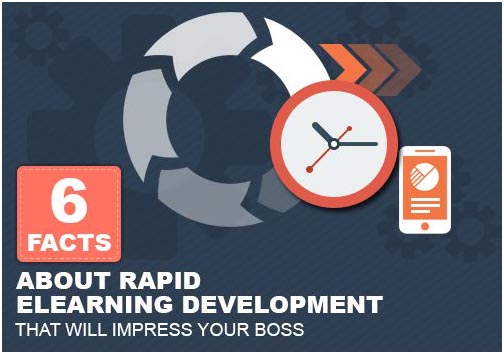
In today’s world, time is at premium and Learning and Development professionals have to balance the quality of eLearning courses within shorter time spans to go-live and within budgets that are shrinking every year. All of these factors have led to increased use of rapid eLearning development as a necessity vis-a-vis traditional eLearning. In this article, I will outline what rapid eLearning is, as well as its advantages and disadvantages. I will then share cues on where it would be a good fit and some tips and best practices that will help you increase the success of these initiatives.
Rapid eLearning Development: What Is Rapid eLearning?
While the definition of rapid eLearning varies, the most common attributes of eLearning courses that can be termed as “rapid eLearning courses” are:
- They can be developed within 2-3 weeks.
- These projects would be led directly by Subject Matter Experts (SMEs) who have written the source content.
- Rapid authoring tools are used that typically facilitate an input of the source content in a format like PowerPoint. Notable examples of rapid authoring tools are Articulate Studio’09, Articulate Studio’13, Snap! by Lectora, Mohive, Claro, and Adapt. However, the traditional eLearning authoring tools like Adobe Captivate, Lectora Inspire, and Articulate Storyline can also be adapted for rapid eLearning development.
- Rapid authoring tools do not require any technical expertise to develop content/courses. Additionally, these tools facilitate an “Easy Publish” of courses into desired standards like standalone (CD/Offline version), SCORM 1.2, SCORM 2004, and AICC.
- Courses can be created through a standard template library of the authoring tools and will have basic levels of interactions and simple assessments.
What Are The Advantages Of Rapid eLearning?
The key factor for the success of rapid eLearning development has been faster turn-around time. Additionally, this development can be handled predominantly by Subject Matter Experts, minimizing the requirement of other resources such as Instructional Designers, visual designers, and programmers.
A summary of the key advantages is as follows:
- Lower development costs.
- Better turn-around time (most courses can go live within 2-3 weeks).
- Design just-in-time training that can respond more dynamically to organizational needs.
- Opportunities for organizations to leverage on internal Subject Matter Expert talent and use them more efficiently and meaningfully.
- Better control on on-going updates or enhancements to courses.
What Are The Disadvantages Of Rapid eLearning?
In spite of several advantages that rapid eLearning offers, “one size does not fit all”. What this means is that this approach will fit certain kinds of projects but will fail to be effective in others. The reason for this is that more often than not, Subject Matter Experts do not have Instructional Design capability and this leads to a learning design that may not engage the learners as effectively (despite great content). So like all choices, there are pros and cons as you opt for rapid eLearning development.
Specifically, Where Would Rapid eLearning Development Succeed?
In my assessment, rapid eLearning development finds a good fit and is successful in the following situations:
-
- Projects that need extensive subject matter input.
As we know, in traditional eLearning projects, Subject Matter Experts pass the raw content to Instructional Designers, who then develop the storyboards. This is further handled by visual designers and programmers to create the eventual project. It is important to note that most of the development process is controlled by professionals who do not have knowledge of the content and may not necessarily have prior experience with it. So, projects that can benefit from an Subject Matter Expert’s direct and continuous engagement are a good fit for rapid eLearning development. Subject Matter Experts can opt for direct development of the courses or work very closely with Instructional Designers to ensure accurate implementation of their brief. - Projects that need to go-live quickly.
Rapid eLearning development is a great fit when you need projects to go-live in a really short lead time (within three weeks or so). Clearly, this goal cannot be met through traditional eLearning development. - Projects that have limited budget or organizations having limited training budgets.
In both situations, rapid eLearning development is the logical choice.
- Projects that need extensive subject matter input.
What Kind Of Situations Adapt Well To Rapid eLearning Development?
Before you select rapid eLearning development, do evaluate if the content falls into one of the following categories. These situations reflect when rapid eLearning development is a great fit and is often a better choice than traditional eLearning:
- When content changes rapidly.
- When content has a short shelf life.
- When you need to provide just-in-time information.
Are There Any Tips Or Best Practices That Will Increase The Success Of Rapid eLearning Development Projects?
Here are some tips and best practices that will ensure the success of your rapid eLearning development:
-
- Identify the time frame to go-live and evaluate if the project (and content) is apt for rapid eLearning development.
- Authoring tool selection.
Confirm if the Subject Matter Expert is familiar with the tool. Otherwise, plan for an associated learning curve and determine if this will impact the planned go-live date. - Readiness of the source content.
Confirm if the existing raw content needs further processing or it is ready to hit development. - Explore the authoring tool and identify the right templates that provide the desired visual impact and will aid learners retain this effectively.
- Engage the learners through relevant interactions.
Use scenarios and pause and reflect templates to help them understand the real-world dynamics. - Select an effective assessment strategy.
Plan for adequate check-points and end of course assessments through varied templates.
I hope this article was useful in understanding the dynamics associated with rapid eLearning development and providing an insight on how you can create successful projects using this approach.
At EI we have a strong, decade old rapid eLearning development practice through which we provide a dedicated panel of Instructional Designers and visual designers who work closely with your Subject Matter Expert and create stunning rapid eLearning courses that are completely template-driven. This value addition can offset the disadvantages of rapid eLearning development while retaining the advantages of lower costs and faster turn-around time. We have several case studies that showcase how we have increased the success factors of these projects manifold.



